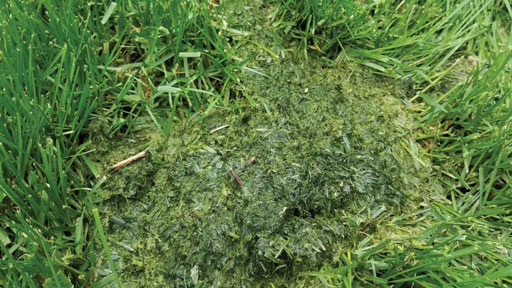What Is HOC?
In reference to lawn or turf, HOC is an acronym for “height of cut”. Cool season grasses such as Heat Wave, Macho Mix, Estate Mix, Blue Wave and Stadium Special, the optimum height of cut is between 3-4 inches. During the cooler spring and fall seasons, the mowing height can be kept closer to three inches. Before overseeding the cool season grasses, low mow to about two and a half inches then move it back up to optimum mowing height.
See Related: Best Practice for Disease Resistance
Different Grasses Require Different Mowing Heights
All lawns are not the same. Cut the grass too short it can become stressed, thin and have a shallower root system. Cutting the grass crowns will result in turf that is vulnerable to weed pressure and require pesticide applications to prevent weeds and discourage pests. Grass cut too short also prevent the plant from using soil nutrients efficiently, while grass kept too long can set you up for turf disease issues. Warm season grasses such as zoysia grass and Bermuda will tolerate a shorter, tighter cut. Cool season grasses, like fescue and bluegrass, need to be mowed taller to help shade the root system and keep heat stress away.
Mowing Too Low Damages Grass
Those who don’t “enjoy the mow” may be moved to cut their grass very low, allowing longer intervals between mowings. However, mowing the grass too low will have a detrimental effect on a lawn. Mowing grass too low will not only stress the grass, but it also causes a myriad of problems to occur. Mowing too low reduces the density of the grass, thus making the lawn susceptible to invasive summer weed pressures. Crabgrass and foxtail need sunlight to grow. By mowing the grass too low, homeowners may unknowingly be promoting crabgrass to grow. Shade provided by a higher cut grass blade shields the crabgrass seeds from much-needed sunlight. Mowing too low makes the turf vulnerable to summer heat as well. Without taller grass blades to shade the summer sun, low mowing can lead to stress damage quickly during long periods of summer drought.
What is the Best Height to Cut My Grass in Winter?
The last mowing of the year should be at your normal mowing height. Cool-season grasses are typically kept from 2 to 4 inches. grasses such as bermuda and zoysia can be kept much shorter. Turf grasses should not be cut extremely low nor allowed to become extremely long prior to winter dormancy.
Uncle’s Tip: Stay off a frozen or frost covered lawn until the frost has dissipated.
Should I Mow My Grass Lower in the Spring?
When you’re ready to give that first mowing in the spring, lower your mower height 1 or 2 notches so you’re mowing your grass about 3 inches tall. Be careful not to scalp your lawn. This low mow will cut off the brown winter grass blades and open up the soil to the warm spring sunlight.
Should I Low Mow My Grass in the Fall?
Early fall is an excellent time for a low mow. When you have a summer-stressed lawn, lower your mower height at the onset of cool fall weather and apply Loveland Renovator or Golf Course Starter to encourage growth, rejuvenating cool-season turf grasses. As shorter days and cooler fall temperatures prevail, crabgrass stops growing. Low mowing the ugly summer weeds will allow your cool-season grasses to rebound and fill in quickly.
Should I Raise the Mowing Height in the Summer?
As the heat of summer arrives, raise your mower height for cool season grasses and keep it closer to four inches. A taller plant shades the soil and keeps the root zone cooler during periods of high heat. If your lawn is allowed to grow too tall, it can result in broader leaf blades, a lower plant density, and more susceptible to turf disease.
How Often Should I Mow My Grass?
Having a routine mowing schedule for your lawn is common. However, you should only mow your lawn when it needs mowing. Grass will grow at different rates depending on fertilization, season, and weather conditions. In the spring, with longer days, cooler temperatures and plenty of rain, grass grows quicker than in the summer.
What Is the One-Third Rule?
Regardless of your grass species, you should not remove more than one-third of the grass height when mowing. This is important because grass is a living plant, and they all undergoes some stress when cut.
How Often Should I Sharpen My Mower Blade?
If you haven’t sharpened your lawn mower blades, you’re not cutting the grass, you’re combing it. Keep your mower blade sharpened! A cleaner cutting blade results in less stress on the turf. A dull mower blade rips and shreds the grass leaf making the plant susceptible to disease. Mowing with a dull blade can lead to turf discoloration. The leaf tips look jagged and turf will have a yellow/brown hue. A good rule of thumb is to sharpen your blade every ten mower hours. Buy an extra blade and keep a sharp spare handy.
Can I Mow My Lawn When It Is Wet?
Avoid mowing your lawn when it is wet. There are several reasons for not mowing a wet lawn. In addition to possibly jamming the mower blades and clogging the discharge chute, it also leaves clumps of grass on the lawn. Grass collecting on the mower blades also results in tearing the grass much like a dull blade. Keeping your lawn mower blades sharp can’t be overstated.
Related: Tips on Mowing in the Rainy Season
Mowing Before Overseeding Lawn
Before overseeding, verticutting or core aerating we recommend a low mow. Set your mowing height down one or two notches lower than your normal mowing height. Be careful not to scalp your lawn. This low mow will allow new baby grass to collect sunlight and not be shaded by taller existing grass blades.
How Long Should You Wait after Overseeding to Mow Your Lawn?
Mow your grass as needed, returning the mower to your routine mowing height. Overseeding requires fertilizing and watering. Existing grass plants will be outgrowing the newly germinating grass seeds. Do not wait and let the grass get too tall and start to fall over. Mature grass blades shade the baby grass plants resulting in a longer, thinner, and less vigorous plant. Maintaining your routine height of cut will let more sunlight reach baby grass plants, allow air movement to reduce risks of turf disease, encourages root growth, and keeps grass clippings to a minimum.
Uncle’s Tip: Use your best judgment when mowing across large repaired patches with baby grass. Avoid sharp radius turns that may cause damage from the wheels.The type and weight of your mower can also play a factor. Residential push type mowers are lighter and would, in most cases, create the least amount of soil disturbance. However, heavier commercial and riding mowers weighing several hundred pounds may cause some disruption under certain conditions. Check the ground to be firm before mowing and use your best judgment.





